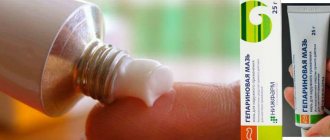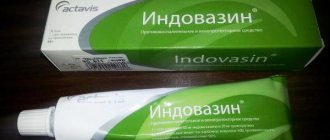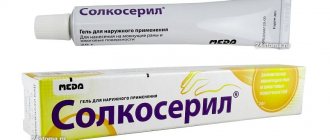Trombless Plus gel for external approx. 50g tube
Indications
- symptom complex of chronic venous insufficiency (including against the background of varicose veins of the lower extremities), migratory phlebitis, thrombophlebitis of superficial veins;
- subcutaneous hematomas, localized edema and aseptic infiltrates;
- injuries and bruises of joints, tendons, muscle tissue;
- complications arising after surgical operations on the veins.
pharmachologic effect
Combined drug.
Sodium heparin is a direct anticoagulant that has anti-inflammatory, antiproliferative, anti-edematous and analgesic effects. Reduces platelet aggregation, binds to antithrombin III, preventing the transition of prothrombin to thrombin. Inhibits thrombin activity. Reduces the activity of hyaluronidase, increases the fibrinolytic properties of blood. Improves microcirculation and activates tissue metabolism, thereby accelerating the processes of resorption of hematomas and blood clots, ultimately restoring the patency of the veins, clinically this is accompanied by a pronounced analgesic and anti-inflammatory effect.
Dexpanthenol - provitamin B5 - is converted in the skin into pantothenic acid, which is part of coenzyme A, which is involved in the processes of acetylation, carbohydrate and fat metabolism; stimulates skin regeneration, normalizes cellular metabolism, increases the strength of collagen fibers. It has a regenerating, vitamin, metabolic and anti-inflammatory effect.
Troxerutin is a flavonoid (derivative of rutin), has P-vitamin activity; has venotonic, angioprotective, decongestant, antioxidant and anti-inflammatory effects. Participates in redox processes, blocks hyaluronidase, stabilizes hyaluronic acid in cell membranes and reduces the permeability and fragility of capillaries, increases their tone. Increases the density of the vascular wall, reduces exudation of the liquid part of the plasma and diapedesis of blood cells. Reduces inflammation in the vascular wall, limiting the adhesion of platelets to its surface.
Benzocaine is a local anesthetic for superficial anesthesia. Reduces the permeability of the cell membrane to sodium ions, displaces calcium ions from receptors located on the inner surface of the membrane, and blocks the conduction of nerve impulses. Prevents the occurrence of pain impulses at the endings of sensory nerves and their conduction along nerve fibers. Benzocaine dilates superficial vessels, promoting the absorption of heparin.
Drug interactions
Combined use of the gel with oral anticoagulants may cause prolongation of prothrombin time. Non-narcotic analgesics and anticholinesterase drugs enhance the effect of the benzocaine included in the drug. Benzocaine reduces the antibacterial activity of sulfonamides.
Dosage regimen
Externally, apply a thin layer to the skin above and around the affected area, evenly distributing over the surface of the skin with light circular movements 2-3 times a day. The course of treatment is 2-3 weeks, repeated if the disease relapses.
For trophic ulcers with weak exudation
Before use, the wound surface is cleaned of exudate and necrotic tissue, if necessary, washed with a solution of hydrogen peroxide 3%, nitrofural 1:5000 or chlorhexidine 0.05% and dried. The gel is applied in an even thin layer over the entire affected surface and a sterile gauze bandage is applied. The dressing is changed once a day. With the open method of treatment, the drug is applied 1-2 times a day. The duration of treatment is determined by the dynamics of epithelization.
For subcutaneous hematomas, localized edema, aseptic infiltrates, injuries, bruises
and similar conditions, apply to the affected area 2-3 times a day until the normal state of the damaged tissue is completely restored.
Overdose
No cases of overdose of Trombless® Plus gel have been reported.
Contraindications for use
- hypersensitivity to the components of the drug;
- open infected wounds or wounds with heavy exudation at the site of intended application;
- children under 18 years of age (there are no data on the effectiveness and safety of the drug);
- pregnancy and lactation period.
Carefully
Increased tendency to bleeding, thrombocytopenia.
Use during pregnancy and breastfeeding
The use of Trombless® Plus during pregnancy and breastfeeding is contraindicated.
Restrictions when breastfeeding
Contraindicated
Restrictions during pregnancy
Contraindicated
Storage conditions
Store the drug out of the reach of children at a temperature not exceeding 25°C.
Terms of sale
The drug is available without a prescription.
special instructions
Not intended for use in ophthalmology, for intravaginal administration.
Side effect
With prolonged use of the drug, local reactions are possible in the form of skin hyperemia, decreased sensitivity (at the site of application), allergic reactions (skin rash, itching).
Possible product names
- Trombless Plus gel for external approx. 50g tube
- TROMBLESS PLUS GEL 50.0
- (Trombless Plus) Trombless Plus gel for external approx. 50g tube
Trombless Plus gel external 50 g tube al/pack card x1
INSTRUCTIONS FOR MEDICAL USE OF THE MEDICINE, Trombless ®, Plus, Registration number: LP-001786 Trade name of the drug: Trombless, Plus International, non-proprietary, or, grouping, name: , Benzocaine, + Heparin sodium + Dexpanthenol + Troxerutin Le karmic form: gel for external use Composition per 1 g Active ingredients: heparin, sodium, – 1000, IU, (8.33, mg, with activity, sodium heparin 120 IU/mg), troxerutin – 20.0 mg, dexpanthenol – 100.0 mg, benzocaine – 1.0 mg, excipients: ethanol, methyl parahydroxybenzoate, trolamine, carbomer, glycerol, purified water. Description: Transparent or translucent gel from light yellow to yellow, a greenish tint is allowed. Has a weak characteristic odor. Pharmacotherapeutic group: anticoagulant, direct, action, for, local, use, +, other drugs ATC code: C05BA53. Pharmacological properties Pharmacodynamics Trombless Plus is a combination drug. Heparin, sodium, is an anticoagulant of direct action, has anti-inflammatory, antiproliferative, decongestant, and analgesic effects. Reduces platelet aggregation, binds to antithrombin, III, preventing the transition of prothrombin to thrombin. , Inhibits the activity of thrombin. Reduces the activity of hyaluronidase, increases the fibrinolytic properties of the blood. , Improves microcirculation and activates tissue metabolism, thanks to this, accelerates the processes of resorption of hematomas and blood clots, and ultimately restores the patency of the veins, clinically this is accompanied by a pronounced analgesic and anti-inflammatory effect. , Dexpanthenol - provitamin B5 - in the skin is converted into pantothenic acid, which is part of the composition of coenzyme A, which is involved in the processes of acetylation, carbohydrate and fat metabolism, stimulates the regeneration of the skin, normalizes , cellular, metabolism, increases the strength of collagen fibers. It has a regenerating, vitamin, metabolic and anti-inflammatory effect, improves the absorption of heparin. Troxerutin, a flavonoid (derivative, rutin), has P-vitamin activity, has venotonic, angioprotective, decongestant, antioxidant, and anti-inflammatory effects. Participates in redox processes, blocks hyaluronidase, stabilizes hyaluronic acid in cell membranes, and reduces the permeability and fragility of capillaries, increases their tone. Increases the density of the vascular wall, reduces the exudation of the liquid part of the plasma and, diapedesis, cells, blood. Reduces inflammation in the vascular wall, limiting the adhesion of platelets to its surface. Benzocaine is a local anesthetic for superficial anesthesia. Reduces the permeability of the cell membrane for sodium ions, displaces calcium ions from receptors located on the inner surface of the membrane, blocks the conduction of nerve impulses. , Prevents the occurrence of pain impulses in the endings of sensory nerves and their conduction along nerve fibers. , Benzocaine, dilates superficial vessels, promoting the absorption of heparin. Pharmacokinetics: A small amount of heparin is absorbed from the skin surface into the systemic circulation. The maximum concentration of the drug in the blood is observed 8 hours after application. Heparin is eliminated mainly through the kidneys, with a half-life of 12 hours. Troxerutin is well absorbed from the surface of the skin when applied externally; penetration into the systemic circulation is clinically insignificant. Dexpanthenol, when applied topically, is quickly absorbed by the skin and converted into pantothenic acid. Its concentration in blood is 0.5-1 mg/l; in serum, blood is 100 μg/l. Pantothenic acid is not metabolized in the body (except for inclusion in coenzyme A), and is excreted unchanged. Benzocaine, when applied cutaneously, is practically not absorbed. , Has an immediate analgesic effect: the speed of onset of the effect begins 1 second after application and lasts on average 4-6 hours. Indications for use: Chronic, venous, insufficiency, accompanied by symptoms such as swelling, pain, feeling, heaviness in the legs, feeling of “fullness,” fatigue, legs, spider veins and spider veins, cramps , paresthesia (feeling of numbness, tingling, “crawling”). Varicose veins of the lower extremities. Migrating phlebitis, thrombophlebitis. Subcutaneous hematomas, localized edema and aseptic infiltrates, including on the face. , Injuries and bruises of joints, tendons, muscle tissue. , Complications arising after surgical operations on the veins. Contraindications for use Hypersensitivity to the components of the drug, violation of the integrity of the skin, in the place of intended application of the drug (open wounds, ulcerative-necrotic lesions), children under 18 years of age (due to lack of data on the effectiveness and safety of the drug in this category of patients). , Increased tendency to bleeding, thrombocytopenia. Use during pregnancy and breastfeeding The use of the drug, Thrombless Plus, during the period of pregnancy and breastfeeding is possible if the potential benefit for the mother exceeds the potential risk. for the fetus and the child. Do not apply to the area of the mammary glands to avoid the drug entering the baby's body. Method of administration and dosage: Apply externally. Unless otherwise recommended by a doctor, then a strip of gel 1-3 cm long (depending on the area of the affected surface) is applied in a thin layer to the skin above and around the affected area, evenly spreading over the surface of the skin using light circular motions. movements 2 times a day. For varicose veins, chronic venous insufficiency and thrombophlebitis, the course of treatment is 2-3 weeks, with a repeated course of treatment in case of relapse of the disease on the recommendation of a doctor. For subcutaneous hematomas, localized edema, aseptic infiltrates, injuries, bruises, complications arising after surgical operations on veins, the drug is used until complete restoration of damaged tissues and resorption of hematomas. If there is no improvement after treatment or new symptoms appear, you should consult your doctor. Use the drug only in accordance with the method of application and in the doses indicated above. If necessary, if you have any questions, consult your doctor before starting to use the drug. Side effects With long-term use of the drug, it is possible to develop local reactions in the form of skin hyperemia, decreased sensitivity (at the site of application), allergic reactions (skin rash, itching), contact dermatitis. The drug, Trombless, Plus, can also cause allergic reactions (possibly delayed) due to the presence of methyl parahydroxybenzoate in the composition. If any of the side effects indicated in the instructions are aggravated, or other side effects not specified in the instructions are noted, you should immediately consult a doctor. Overdose No cases of overdose of the drug Trombless Plus gel have been reported. The extremely low systemic absorption of the active components of the drug when used externally makes overdose almost impossible. In case of overdose, you should rinse off the excess gel with a large amount of running water and immediately seek medical help. In case of accidental or intentional ingestion of the gel, rinse the stomach and immediately seek medical attention. help. Interaction with other drugs Combined use of the gel with oral anticoagulants may cause prolongation of prothrombin time. Non-narcotic, analgesics, and anticholinesterase drugs enhance the effect of the benzocaine included in the drug. Benzocaine reduces the antibacterial activity of sulfonamides. Special instructions It is not recommended to apply to mucous membranes, open wounds, and to use in the presence of purulent lesions at the intended site of application of the gel. During breastfeeding, you should avoid applying the drug to the area of the mammary glands to avoid swallowing the drug by the baby. In case of accidental contact with eyes or other mucous membranes, rinse them thoroughly with running water. Do not exceed the maximum duration and recommended doses of the drug without consulting your doctor! With prolonged use of the drug on large areas of the skin, and the simultaneous use of indirect anticoagulants (warfarin, syncumar, etc.), prothrombin time and blood clotting time should be monitored (due to the presence of sodium heparin in the drug ). It is not recommended to use the drug, Thrombless ®, Plus, for thrombosis of the deep veins of the legs. The drug is not intended for use in ophthalmology and for intravaginal administration. Effect on the ability to drive vehicles and machinery The drug does not affect the ability to perform potentially hazardous activities that require increased concentration of attention and speed of psychomotor reactions (including driving vehicles, working with moving mechanisms). Release form Gel for external use 1 mg/g + 1000 IU/g + 100 mg/g + 20 mg/g. 10, 20, 30, 40, 50 or 100 g in aluminum tubes or polyethylene laminate tubes. Each tube, together with instructions for the medical use of the drug, is placed in a cardboard pack. Storage conditions: At a temperature not exceeding 25 С. Keep out of the reach of children. Shelf life: 3 years. Do not use the drug after the expiration date. Conditions of release, Dispensed without a prescription.





